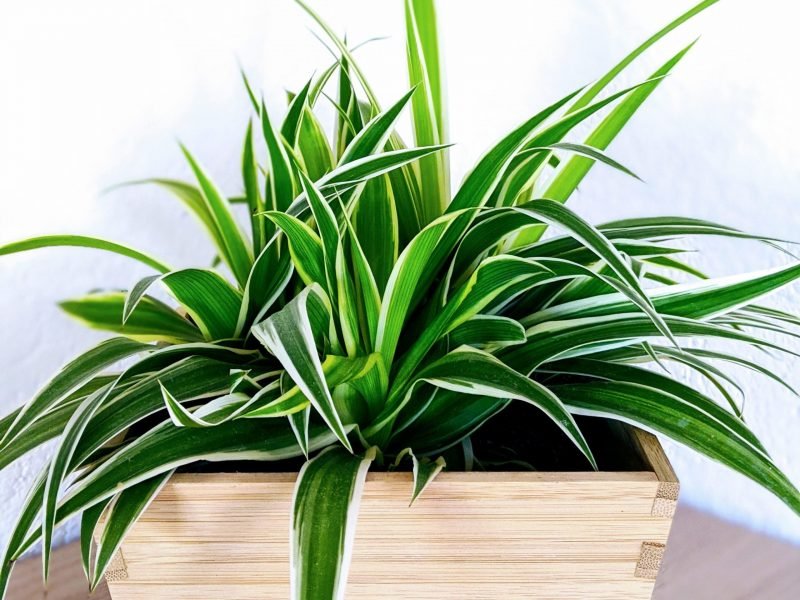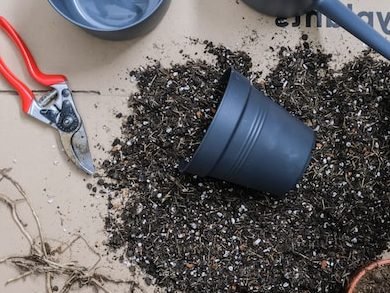
Often recommended as a beginner houseplant or the perfect thing if you don’t have a green thumb, the Spider Plant isn’t totally fuss free. Yes, they can adjust to a variety of environments and are certainly easier to care for than a lot of other plant types, but just with any other plant, if something isn’t right it can lead to your Spider Plant being distressed. This can often result in your Spider Plant losing leaves.
To determine whether the cause of the leaf drop is a serious problem, or if it’s just part of the ageing process, we have written a complete guide to the various causes. We hope this will help you figure out what is wrong with your Spider Plant and prevent any more leaves from falling off your plant.
Overwatering is a common cause of Spider Plants losing leaves
If you find that your Spider Plant is losing leaves from the bottom up, then it may be a problem with the roots that is causing the issue. When the root system is damaged, you’ll notice the issue starting there and progressing throughout the plant, resulting in a variety of problems including leaf drop.
Spider Plants can tolerate some soggy soil but hate sitting in water for long periods of time. Once the roots start to rot, it means the root system is unable to get the needed oxygen, water and nutrients to the rest of the plant. This will mean your Spider Plant can’t maintain the level of healthy growth that it has and it will start to lose some leaves.
If you think that your Spider Plant is waterlogged and this is why it’s losing leaves, check the moisture of the soil immediately using a moisture meter and adjust your watering schedule accordingly. This could be cutting back on how often you water your plant, or just reducing the amount of water you give each time. We also recommend replacing the potting soil straight away (rather than waiting for it to naturally dry out) so that the roots can begin to recover and resume healthy growth.
In future, to prevent your Spider Plant from losing more leaves, try to regulate your watering and always check that the top of the soil is dry before giving your Spider Plant any more water. You need to also water according to the seasons; in the spring and summer (growth period) your Spider Plant will require water about every 5-6 days. However, in winter (dormant period) about once every few weeks is enough.
Underwatering can also cause your Spider Plant to lose leaves
Funnily enough both over-and underwatering can lead to your Spider Plant losing leaves. Holding back water to an underwatered plant, or increasing how much you water an overwatered plant will be fatal for your Spider Plant so it’s crucial that you figure out which one is happening before adjusting your watering schedule.
Here’s how to spot if your Spider Plant is losing leaves due to being underwatered:
Leaves are dry and crispy
If the leaves that are falling off your Spider Plant are very dry, crispy, shrivelled and look dehydrated, then the problem is probably consistent underwatering.
The potting mix is dry
An easy way to see if your Spider Plant is losing leaves due to a lack of water is by taking the plant out of its pot and inspecting the potting mix. If the soil feels very dry to touch, almost like dust, then your plant needs more water. You might also notice that the root system looks quite crinkled and dry. This also indicates underwatering. If this is the case, trim away any crispy roots to encourage your plant to grow new healthy roots.
The soil is coming away from the sides of the pot
This is a great method to be able to tell if your Spider Plant losing leaves because it is being underwatered just by looking at it and is something to do each time you water. If you notice that the soil has compacted and is actually coming away from the sides of your pot, then it indicates that you need to increase watering and this may be the cause of your Spider Plant losing leaves. This also goes for all of your houseplants so is something to keep in mind.
Use a moisture meter
Just like with overwatering above, using a moisture meter will help figure out how dry the potting mix is and if you need to water your Spider Plant more to stop it from losing any more leaves.
How do I fix an underwatered Spider Plant?
Now that you’ve established that your Spider Plant is losing leaves due to a consistent lack of water, you need to make sure to reverse the issue in the right way. Your first instinct may be to drown your plant in water but this can actually cause your Spider Plant to go into shock due to a sudden change of environment. To prevent this from happening, we recommend slowly reintroducing water by giving it a little bit once a day for a week. This will slowly dampen the potting mix and hopefully, stop your Spider Plant from losing any more leaves.
Your Spider Plant might be losing some leaves due to natural ageing
If it’s only the oldest bottom leaves on your Spider Plant that are falling off, then this may be natural ageing. As your plant matures, your Spider Plant will lose some of its oldest, lowest leaves to focus its energy on growing new healthy and often bigger growth.
This is completely natural and isn’t a cause for concern. To make sure that something else isn’t going on, we recommend you monitor how many leaves are falling off your plant. As long as the rate is slow, and your Spider Plant is producing much more new, healthy growth, then you shouldn’t worry about this at all.
These are the three most common reasons why Spider Plants start losing their leaves. The first port of call is establishing whether or not it is natural ageing or a problem with watering that is causing the leaf drop. If watering is the issue, it’s important to be 100% sure whether it is overwatering or underwatering. Adjusting your watering schedule in the wrong way might just be the thing that tips it over the edge and makes it impossible to revive your Spider Plant. If things aren’t looking so good, then we recommend propagating some of the spiderettes that might be hanging on your plant so that at least you have some healthy baby plants to nurture.
Check out our Spider Plant care guide for everything you need to know about caring from your plant, as well as propagation advice, general top tips and how to treat other problems you might face with your plant.















